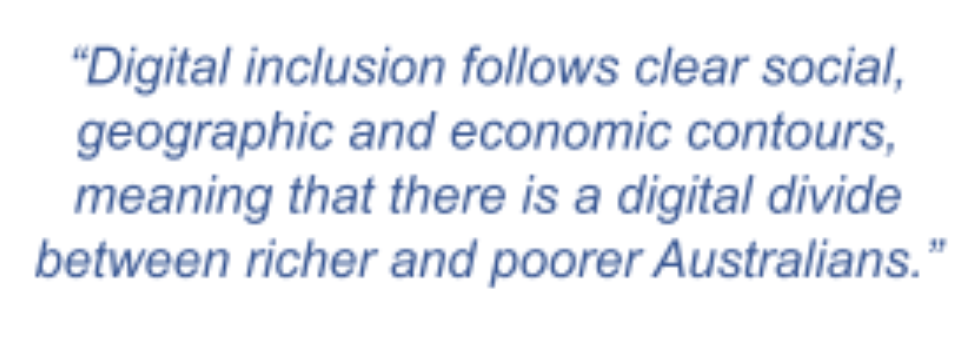
With the onset of the COVID-19 pandemic, educators across the globe have been required to establish learning from home for school students, resulting in the rapid roll out of remote online learning. In light of this phenomenon, this article discusses the impact of remote online learning on Australia’s advancement of UN Sustainable Development Goal 4 (Quality Education) and Sustainable Development Goal 10 (Reduced Inequalities).
In Victoria, schools closed on 25 March and later re-opened for the children of people working in essential services, which accounted for roughly 10% of all Victorian school children. This was followed some weeks later by the return to school of prep and grade one children, and students completing their Victorian Certificate of Education (VCE). But throughout most of term 1 and 2, 2020, Victorian children have been schooled from home, which has led to particularly challenging circumstances for some families.
Quartz Media captures the difficult predicament many educators found themselves in as a result of the rapid transition to online learning. If teachers didn’t move online, all students would have missed out on months of the school curriculum; but when they did teach online, a sizeable group of students were significantly disadvantaged.
Despite such short notice, online learning technologies enabled many primary and secondary students to continue to meet their learning objectives, but remote online learning has not been possible for all students. One key reason for this is ‘the digital divide’ that exists between students from high socio-economic (SE) backgrounds and those from low SE backgrounds.
This article seeks to highlight how and why the digital divide impacts upon school students from low SE backgrounds in a disproportionately negative way as compared with their high SE peers. With the projected increase in remote online learning continuing in our post-COVID world, it is critical that the causes and implications of the digital divide are well-understood if we are to pursue an equitable education system.
Who is left behind?
Educationalists note that students from low SE backgrounds face a much higher risk than their peers of ‘digital exclusion’ from remote online learning. Students who also face a higher risk of digital exclusion are those:
● who live with a disability;
● with additional learning needs;
● who live with particular mental health conditions;
● who are Aboriginal or Torres Strait Islander, since digital exclusion is more severe in remote communities due to low-speed internet and less reliable telecommunications networks; and
● from culturally and linguistically diverse (CALD) groups, as language barriers are exacerbated in online fora.
Whilst these students face a higher risk of digital exclusion, particular care needs to be taken not to stigmatise or categorise all young people who share these particular characteristics. As certainly not all students in these groups are digitally or educationally disadvantaged.
Problematically, digital exclusion is yet another obstruction to the existing barriers to learning that many disadvantaged students already face. For instance, the Department of Education indicates that the average 15-year old Australian from a low SE background is three years behind their peers from a high SE background.
Why are they left behind?
Whilst this discussion is specifically focussed on ‘the digital divide’, there are many other reasons why disadvantaged students, including those from low socio-economic backgrounds, may be excluded from remote online learning. The Mitchell Institute notes the following five key reasons:
1. The Material Divide – gaps in basic resources that families require to support home learning.
2. The Digital Divide – gaps in technological resources and skills.
3. The Skills and Dispositions Divide – students not being personally equipped for home learning, as measured by barriers such as low-level language skills.
4. The Parental Support Divide – some parents are not well-prepared or able to cope with the additional demands of home-schooling children.
5. The Adjustments Divide – learning adjustments schools use for particular disadvantaged students, such as one-on-one support, teaching aides or reduced class sizes, are not suited to, or possible in home learning arrangements.
The Digital Divide in Australia
The Australian Digital Inclusion Index (ADII) is used to provide a picture of digital inclusion in Australia.
Digital inclusion refers to a person’s ability to access, afford and use digital resources in ways that enable them to connect to and use online technologies effectively.
The ADII indicates that digital inclusion follows clear social, geographic and economic contours, meaning that there is a digital divide between richer and poorer Australians. A recent ADII report noted that, whilst digital inclusion is improving, the benefits of the digital economy still cannot be shared with some members of the community due to persistent barriers to online participation.
The ADII stated that this is particularly concerning given the growing range of essential educational services that are moving online. The 2019 ADII report states:

Access, Affordability and Ability
The ADII defines digital inclusion as pertaining to three key factors influencing a students’ experience of online learning: access, affordability, and ability.
Access
This factor refers to access to internet connectivity. The Mitchell Institute states that only 3% of high-income households don’t have access to the internet, but this increases to 33% among the lowest income Australian households. The Mitchell Institute indicates that this discrepancy becomes even more pronounced in rural or remote communities, where users pay significantly more for their data allowance than those living in cities. Further, according to an OECD survey of 15 year-olds, approximately 18% of Australian students from low SE backgrounds do not have a computer for schoolwork.
Affordability
Although it is becoming increasingly cheaper to purchase devices, including laptops and tablets, the University of Tasmania’s ‘Learning at home during COVID-19’ report stated that digital device affordability is still significant barrier preventing students from engaging in remote online learning. They found that some students did not have a device at home, or were required to share a single device between siblings and parents. Other students were using devices not properly suited for online learning, like mobile phones.
Ability
This factor refers to the ability to effectively utilise online technologies. The OECD survey revealed that Australian students from a low SE background frequently had the lowest level of interest, ability and capacity to work independently with technology. Educators stated one reason for this is because these students can have less exposure to technology and therefore have less opportunity to build their digital literacy.
The Mitchell Institute states that ‘ability’ also refers to being in the right environment to effectively utilise the digital resources, which some low socio-economic students may not have, for instance their own private study space.
These aspects demonstrate the concerning extent to which students from low socio-economic backgrounds may be excluded from remote online learning.
In seeking to address these issues, schools, governments, not-for-profit organisations, businesses and individuals have made remarkable contributions to providing devices and assistance to many young people in need. For instance, Telstra provided 26,000 dongles to assist Victorian students connect to the internet whilst learning from home. Additionally, volunteers of the Brotherhood of St Laurence have been conducting study support groups via video-conferencing platform, Zoom.
Using digital learning to enhance future education
COVID-19 has deepened our understanding of digital education tools and is predicted to have a catalysing effect on our implementation of them. Educators recognise the benefits of using ‘blended education models’ which combine both face-to-face instruction with digital remote learning tools.
Some benefits of online learning relate to flexibility, personalised curriculum, facilitating communication and collaboration between students in geographically disparate areas, and drawing on excellent learning resources available on the internet.
Whilst many students are beginning to return to schools, it is expected that reliance and emphasis on digital education tools and online remote learning will continue long into the future. Given the different learning styles of students, it is critical that all members of our community, including educators and policymakers, understand the varying needs and capabilities of students, including those from low socio-economic backgrounds.
The Department of Education’s recently announced independent analysis into remote online learning may assist in meaningfully addressing this issue. To ensure all stakeholders are considered, one must hope that this analysis captures the voices of metropolitan and regional students at both primary and secondary levels of education.
With greater understanding and assistance, all students can equally enjoy the many educational benefits of technology alongside their peers.
How you can help disadvantaged students
There are a number of not-for-profit organisations that are accepting donations towards providing educational assistance to students from low SE backgrounds, such as The Smith Family, the Brotherhood of St Laurence and Save the Children.
Written by: Casey Temple, Partnerships Coordinator, UNAA YP Network
Edited by: Maeve Martyn, Marketing and Communications Manager, UNAAV YP Network